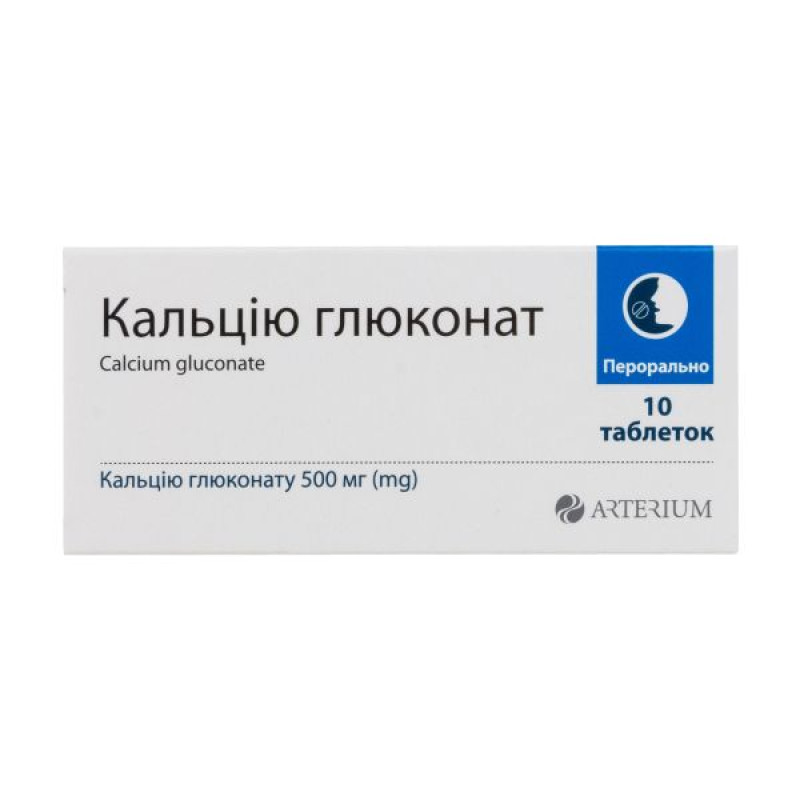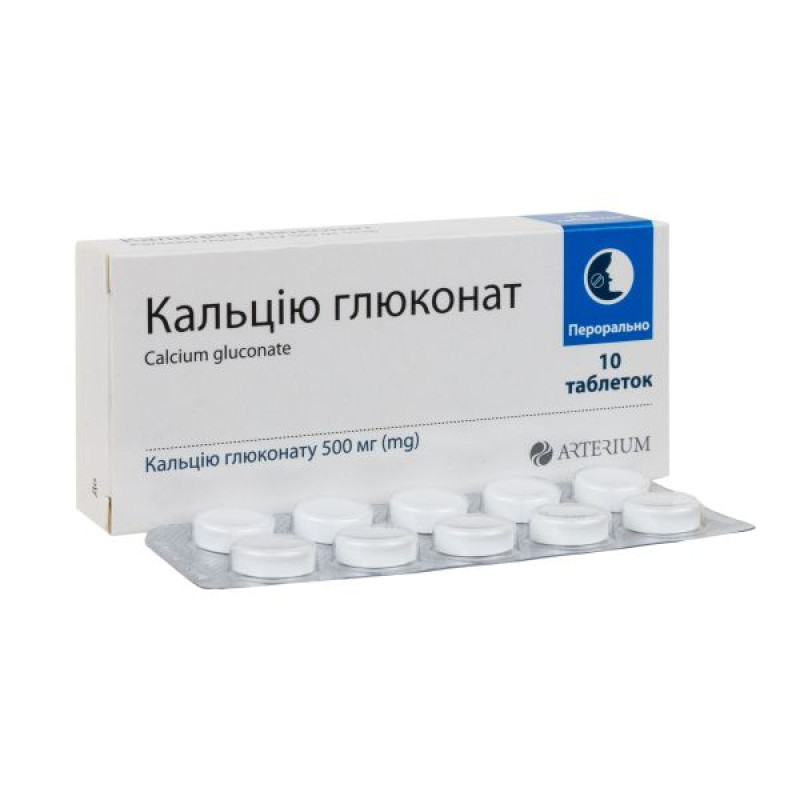Calcium gluconate tablets 500 mg blister No. 10

Instructions Calcium gluconate tablets 500 mg blister No. 10
Composition
active ingredient: calcium gluconate.
1 tablet contains calcium gluconate in terms of 100% substance – 500 mg;
excipients: potato starch, croscarmellose sodium, talc, calcium stearate.
Dosage form
Pills.
Main physicochemical properties: white, flat-cylindrical tablets, with a score and a bevel.
Pharmacotherapeutic group
Calcium preparations.
ATX code A12A A03.
Pharmacological properties
Pharmacodynamics
Calcium gluconate is a calcium salt of gluconic acid containing 9% calcium. Calcium ions are involved in the transmission of nerve impulses, contraction of smooth and skeletal muscles, myocardial function, and blood clotting processes; they are necessary for the formation of bone tissue and the normal functioning of other systems and organs. The concentration of calcium ions in the blood decreases in many pathological processes; severe hypocalcemia contributes to the occurrence of tetany. Calcium gluconate, in addition to eliminating hypocalcemia, reduces vascular permeability, has anti-allergic, anti-inflammatory, hemostatic effects, and also reduces exudation. Calcium ions are a plastic material for the skeleton and teeth, participate in various enzymatic processes, regulate the speed of nerve impulse conduction and the permeability of cell membranes. Calcium ions are necessary for the process of neuromuscular transmission, to maintain the contractile function of the myocardium. Unlike calcium chloride, calcium gluconate has a weaker local irritant effect.
Pharmacokinetics
When taken orally, calcium gluconate is partially absorbed, mainly in the small intestine. The maximum concentration in blood plasma is reached after 1.2–1.3 hours. The half-life of ionized calcium from blood plasma is 6.8–7.2 hours. Penetrates the placental barrier and into breast milk. Excreted from the body with urine and feces.
Indication
Diseases accompanied by hypocalcemia, increased permeability of cell membranes, impaired conduction of nerve impulses in muscle tissue. Hypoparathyroidism (latent tetany, osteoporosis), impaired vitamin D metabolism (rickets, spasmophilia, osteomalacia), hyperphosphatemia in patients with chronic renal failure. Increased need for calcium (period of intensive growth in children and adolescents, pregnancy, breastfeeding), insufficient Ca2+ content in food, impaired metabolism in the postmenopausal period, bone fractures. Increased excretion of Ca2+ (prolonged bed rest, chronic diarrhea, hypocalcemia with prolonged use of diuretics, antiepileptic drugs, glucocorticosteroids). In complex therapy: bleeding of various etiologies, allergic diseases (serum sickness, urticaria, scurvy syndrome, pruritic dermatoses, angioedema); bronchial asthma, dystrophic alimentary edema, pulmonary tuberculosis, eclampsia, parenchymal hepatitis, toxic liver lesions, nephritis. Poisoning with magnesium salts, oxalic acid, soluble salts of hydrofluoric acid (when interacting with calcium gluconate, insoluble and non-toxic calcium oxalate and calcium fluoride are formed).
Contraindication
Hypersensitivity to the components of the drug, hypercalcemia, severe hypercalciuria, hypercoagulation (increased blood clotting), tendency to thrombosis, severe atherosclerosis, nephrourolithiasis (calcium), severe renal failure, sarcoidosis, taking digitalis preparations.
Interaction with other medicinal products and other types of interactions
The drug slows down the absorption of estramustine, etidronate and other bisphosphonates, quinolones, tetracycline antibiotics, oral iron preparations and fluoride preparations (the interval between their administrations should be at least 3 hours). Calcium gluconate reduces the bioavailability of phenytoin. When taken simultaneously with vitamin D or its derivatives, calcium absorption increases. Cholesterolamine reduces calcium absorption in the digestive tract. When the drug is used together with cardiac glycosides, the cardiotoxic effects of the latter are enhanced. Glucocorticosteroids reduce calcium absorption. When combined with thiazide diuretics, the risk of hypercalcemia increases. The drug may reduce the effect of calcitonin in hypercalcemia, the bioavailability of phenytoin, the effect of calcium channel blockers. When used simultaneously with quinidine, intraventricular conduction may slow down and quinidine toxicity may increase.
Forms insoluble or sparingly soluble calcium salts with carbonates, salicylates, and sulfates.
Some foods (spinach, rhubarb, bran, grains) can reduce calcium absorption from the gastrointestinal tract.
Application features
When used in patients receiving cardiac glycosides and/or diuretics, as well as during long-term treatment, the concentration of calcium and creatinine in the blood should be monitored. In case of an increase in their concentration, the dose of the drug should be reduced or its use should be temporarily discontinued. Due to the fact that vitamin D3 increases the absorption of calcium from the gastrointestinal tract, in order to avoid calcium overdose, it is necessary to take into account the intake of vitamin D3 and calcium from other sources.
Patients with mild hypercalciuria (more than 300 mg/day = 7.5 mmol/day), mild renal impairment, and a history of urolithiasis should be prescribed calcium gluconate with caution and the urinary calcium excretion should be monitored regularly. If necessary, the dose of the drug should be reduced or discontinued. Patients with a tendency to urinary calculi should be advised to increase their fluid intake during treatment.
During treatment with the drug, high doses of vitamin D or its derivatives should be avoided, unless there are special indications for this.
An interval of at least 3 hours should be observed between taking calcium gluconate tablets and oral preparations of estramustine, etidronate and other bisphosphonates, phenytoin, quinolones, tetracycline antibiotics, oral iron preparations and fluoride preparations.
Ability to influence reaction speed when driving vehicles or other mechanisms
The drug does not affect the reaction speed when driving vehicles and working with complex mechanisms.
Use during pregnancy or breastfeeding
The use of the drug is permissible taking into account the benefit to the woman/risk to the fetus (child), which is determined by the doctor. When using calcium preparations during breastfeeding, it is possible for it to penetrate into breast milk.
Method of administration and doses
It is prescribed orally before meals. The tablet must be chewed or crushed.
Adults and children over 14 years of age are prescribed the drug in a single dose of 1–3 g (2–6 tablets), children aged 3 to 4 years – 1 g (2 tablets), 5 to 6 years – 1–1.5 g (2–3 tablets), 7 to 9 years – 1.5–2 g (3–4 tablets), 10 to 14 years – 2–3 g (4–6 tablets) 2–3 times a day. The daily dose for elderly patients should not exceed 2 g (4 tablets) per day.
The duration of treatment is determined by the doctor individually, depending on the patient's condition.
Children
The drug is used in children aged 3 years and older.
Overdose
With prolonged use in high doses, hypercalcemia with deposition of calcium salts in the body is possible, dyspeptic phenomena are possible. The likelihood of developing hypercalcemia increases with simultaneous treatment with high doses of vitamin D or its derivatives.
Symptoms of hypercalcemia: drowsiness, weakness, anorexia, abdominal pain, vomiting, nausea, constipation, polydipsia, polyuria, increased fatigue, irritability, malaise, depression, dehydration, possible cardiac arrhythmias, myalgia, arthralgia, arterial hypertension.
Treatment: drug withdrawal; in severe cases, parenteral calcitonin at a dose of 5–10 IU/kg body weight per day (diluted in 500 ml of sterile saline solution, intravenously dripped over 6 hours. Slow intravenous jet injection 2–4 times a day is possible).
Adverse reactions
The drug is usually well tolerated, but sometimes there may be violations:
from the digestive tract: nausea, vomiting, diarrhea, epigastric pain, constipation; with prolonged use in high doses - the formation of calcium stones in the intestines;
Cardiovascular system: bradycardia;
Metabolic: hypercalcemia, hypercalciuria;
From the urinary system: impaired renal function (frequent urination, swelling of the lower extremities).
Allergic reactions are possible.
These phenomena quickly disappear after reducing the dose or discontinuing the drug.
Expiration date
8 years.
Storage conditions
Store in the original packaging at a temperature not exceeding 25 ºС.
Keep out of reach of children.
Packaging
500 mg tablets, No. 10 in a strip; No. 10 in a blister, 1 blister in a pack.
Vacation category
Without a prescription.
Producer
PJSC "Kyivmedpreparat". PJSC "Halychpharm".
Location of the manufacturer and its business address
PJSC "Kyivmedpreparat", Ukraine, 01032, Kyiv, Saksaganskoho St., 139.
PJSC "Halychpharm", Ukraine, 79024, Lviv, Opryshkivska St., 6/8.
There are no reviews for this product.
There are no reviews for this product, be the first to leave your review.
No questions about this product, be the first and ask your question.





